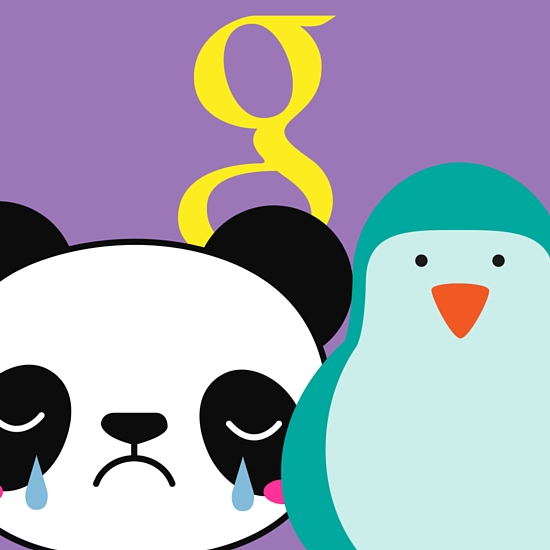
Google has been very busy updating algorithms to reward high-quality websites over spammy websites and blackhat SEO. The Penguin, Panda and “Mobile-geddon” algorithm shifts have been the most notorious as of late, and ever since 2013, it seemed that we were a victim experiencing incredibly low search engine rankings.
For years, we appeared in the top three spots for keywords like “cheap 11×17 printing” or “11×17 poster printing” or “11×17 flyer printing” but at some point, we fell back to the third or fourth page for everything. This even occurred with exact title matches.
When we checked in with Google Webmaster Tools, there was never notification (manual action) indicating Google penalized us, but we knew something was obviously awry since our rankings dropped on almost every thinkable keyword or key-phrase aside from our actual name (which means we were not banned). There was an unmistakable algorithm penalty happening, and it practically drove me insane. Two years ago, I swear I was a very handsome man, but the last year converted me into a balding goblin. We always thought penalties were stemming from Penguin (focused on spam), but now we also think we were being nailed by Panda (focused on quality) as well.
Things are better now. We are ranking on the front page for many keywords, but it is still unclear exactly how or why we made a comeback. Besides precious time, there were many steps and factors that probably contributed to our turnaround success. We hope our experience can help and motivate some of you to continue fighting for a brighter online future.
We moved our website to Shopify
While penalized, we were using a custom WordPress oriented e-commerce solution. Moving to Shopify solved many problems including security and speed (WordPress possesses a reputation for being slow). Most of Shopify’s template designs are also responsive, include rich snippets, breadcrumbs and other code stuff Google likes.
I do want to clarify that WordPress isn’t bad for SEO, but it does have it’s flaws in certain environments. We continue to use WordPress for other solutions outside of our core e-commerce website.
Changed hosting
Switching to Shopify ensures our website lives on reliable, fast and well-liked servers. Although we already briefly mentioned switching to Shopify, we felt a hosting change deserves recognition.
Implemented responsive design
A mobile-friendly website is huge for gaining web traffic especially now that Mobile-Geddon has occurred. Thanks to Shopify, our company adopted a responsive design very easily way before Google updated, and we’re glad we did.
Created a disavow file
If you have spammy links pointing to you, many professionals recommend creating a disavow links file for Google Webmaster Tools (now called Google Search Console). We disavowed all spammy or low-quality links attained during a time we hired a bad SEO company to help us gain links. We didn’t report any legitimate links or poor quality links attained before or after the time period of our bad behavior.
Moved our blog
We separated our blog into a new subdomain (blog.printkeg.com). Shopify offers a blogging feature, but we decided to stick with WordPress. First, Google sees sub-domains and domains as a separate place so a penalized printkeg.com would not affect our blog posts any longer. Second, if we ever decided to move away from Shopify, it might be a major pain to move all of our blog posts. Third, WordPress is an excellent blogging platform, so we wanted to continue using if for that purpose.
We also moved our support center to a sub-domain. This was more a user experience concern since it seemed logical to keep information organized.
Removed all duplicate content
This is a huge issue, and we had to address many troublesome areas. To remove all duplicate content, get rid of redundant pages, use 301 redirects and implement canonical tags.
Fixed all title tag errors
Every title tag should be unique and be within the proper amount of characters. Each tag should also include the core keyword or for that page.
Here is advice from Moz:
Google typically displays the first 50-60 characters of a title tag, or as many characters as will fit into a 512-pixel display. If you keep your titles under 55 characters, you can expect at least 95% of your titles to display properly.
Fixed all description tags
Descriptions should be used to help with CPC and overall quality of the website. It is utter importance from a search marketing standpoint, but not concerning search engine rankings. Google stopped using description tags as a ranking factor back in 2009.
Addressed missing alt and title tags on images.
Google is explicit in communicating that alt tags are important. Be sure every single image on your website has a nice alt tags for search engines to read. Use this tag to describe the image content and refrain from keyword stuffing. The title tags of an image are intended for readers and visitors. We believe every image should include both tags.
Fixed all broken links
Google explicitly tells us broken links are not factored into rankings (yet), but that sounds like hogwash to me. First, it is good website hygiene to update outgoing and incoming links. Secondly, it seems like a great indicator for Google to measure a page’s present-day relevance. Although broken links are not a factor in Google’s algorithm, they could still affect rankings indirectly.
Removed low textual or “thin” pages
We used to post mini-announcements on our blog, but we ended that practice. We also improved any pages that we could and removed the rest. Poor quality pages can hurt your website’s rankings thanks to the Panda update.
Improved past blog pages
Many of our blog posts were interesting enough but well below 500 characters. Raven recommends that each page consists of at least 250 characters, but many experts believe in a safer minimum of 500.
Waited patiently
Some changes will result in immediate results, and others could take months as Google releases new updates. Google announces some updates and keeps others secretive which is why good behavior may take a time to be recognized. As you make alterations, continue to stay on the light side of the force and eventually you will be rewarded.
Stop worrying about Google
Our rankings were so bad, we often found ourselves debating whether or not to abandon our URL and start fresh. I rejected this notion for a variety of reasons. First, we have built trust with thousands of customers so changing our URL just didn’t seem logical. We decided to make adjustments the best we could and find other ways to build qualified organic traffic. This may sounds crazy, but we just stopped worrying about what Google organically thought about us and focused on more on Facebook.
We Keep adding new worthy and valuable content
This strategy requires us to write frequently. We focus on topics that our customers and new visitors might enjoy. Since our print business focuses on entrepreneurs, graphic designers, and artists, we write articles for them. Some articles are tutorial in nature, and others are simple entertaining.
We update product pages and old blog posts regularly
I make a real effort to add more valuable content to past posts and old product pages. This not only keeps those pages fresh, but also adds more value for customers. It’s a win-win situation. With products, we might add new reviews or more specifications. With old blog posts, we might update the content, fix links or add more insightful information. The search engines and visitors will appreciate this extra work.
In the end, it’s about value and quality. I know it feels tired to read “Content is king” but I still truly believe that is true.


